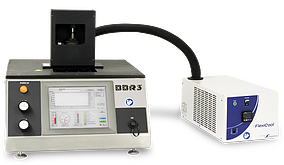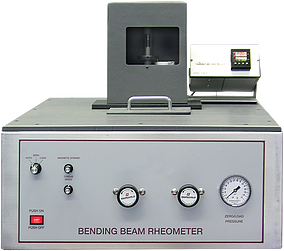
H-1642T.XX
Bending Beam Rheometer (BBR3) with Touch-Screen Control
The BBR3 provides enhanced capabilities and features a large touch-screen.

H-1642.XX
Rheometer - Bending Beam
Performs flexural tests on asphalt binder and similar specimens.
Bending Beam Rheometer (BBR)
The Bending Beam Rheometer (BBR) test provides a measure of the low temperature stiffness and relaxation properties of asphalt binders. These parameters give an indication of an asphalt binder’s ability to resist low temperature cracking. The BBR is engineered to perform flexural tests on asphalt binder and similar specimens per ASTM D6648 and AASHTO T313.
These tests consist of a constant force being applied to a specimen in a chilled bath in order to derive specific rates of deformation at various temperatures. The system consists of a fluid bath base unit, a three-point bending test apparatus which is easily removed from the base unit for specimen loading and unloading, an external cooling unit with temperature controller, a calibration hardware kit with carrying case, and a PC and the testing software.
Determination of flexural creep stiffness
The BBR System consists of a fluid bath base unit, a three-point bending test apparatus which is easily removed from the base unit for specimen loading and unloading, an external cooling unit with temperature controller, and a calibration hardware kit with carrying case. The system is supplied complete with PC and testing software.
This test method covers the determination of the flexural creep stiffness or compliance of asphalt mixtures by means of a bending beam rheometer. It is applicable to material having a flexuralstiffness value from 2 GPa to 20 GPa (creep compliance values in the range of 0.5 nPa–1 to 0.05nPa–1). The test apparatus is designed for testing within the temperature range from –36 to 0°C.
Humboldt Bending Beam Rheometers
Bending Beam Rheometers from ATS are offered from Humboldt. Both are designed to measure the flexural creep stiffness of asphalt binder from ambient to -40°C to predict low-temperature thermal cracking of asphalt pavements. Special molds form small beam samples of binder for testing, and the deflection of the beam is recorded as a constant load is applied. Load, displacement, and bath temperature are displayed in real-time via tabular and graphic forms.
Both models use an air-bearing system to ensure reliable loading with accurate and repeatable results. A linear variable displacement transducer (LVDT) with a range of 6.35mm and accuracy of ±2µm measures deflection. The stainless steel three-point bend apparatus is easily removed and reinstalled in the base unit for convenient sample preparation and loading.
A fluid bath controls the temperature of the Ethylene Glycol/Water/Methanol mixture down to -40°C (-40°F). Process temperature is controlled by two independent platinum RTD temperature transducers to maintain stability. Both models fully comply with ASTM/AASHTO requirements. A source of clean, dry, compressed air at 50 PSIG minimum must be provided by the user.
The H-1641T Bending Beam Rheometer
The Bending Beam Rheometer 3 (BBR3) has been designed to perform flexural tests on asphalt binder and similar specimens as part of the PG grading system according to Superpave. The BBR3 is a state-
Programmable test parameters allow the user to define a test and save those parameters for later testing. Predefined test parameters include the standard ASTM BBR test, as well as the crack sealant test and the sliver test. The BBR3’s programmable test parameters include: Deflection Plot, Load Plot, Bath Temperature, Stirrer Speed, Specimen size, Testing Times, Load, and Testing Company.
Programmable test parameters allow the user to define a test and save those parameters for later testing. Predefined test parameters include the standard ASTM BBR test, as well as the crack sealant test and the sliver test. The BBR3’s programmable test parameters include: Deflection Plot, Load Plot, Bath Temperature, Stirrer Speed, Specimen size, Testing Times, Load, and Testing Company.
The BBR3 features a Displacement Transducer accuracy of 0.097 micron, a measurement resolution of 0.006g, and a Deformation Accuracy of 0.097. While other BBR models may favor Peltier cooling, the BBR3 operates more efficiently without it. Reporting features on the new BBR3 include the ability to name your sample and enter any important notes. With the new BBR3, your data is collected twice per second in addition to these new features, BBR3 users now also have the ability to upload their company logo directly into their test report.
The H-1642 Bending Beam Rheometer
The unit features an integral, stainless steel load frame and in-line, blunt-point loading shaft. The large, easy-to-read digital display shows load, displacement, and bath temperature for ease of setup and operation. Real-time displacement, loading, and temperature graphs are displayed during the test cycle and can be re-plotted and re-scaled as needed for easy viewing.
The BBR uses a linear, variable-displacement transducer (LVDT) with a range of 6.35mm and accuracy to ±2mm measures deflection. The temperature-compensating 500g load cell with mechanical overload protection ensures accurate load results. Safe, rapid cooling of the ethylene glycol mixture test fluid to -40° to 25°C is provided by a mechanical refrigeration system. Process temperature is controlled and monitored by two, independent, platinum RTD temperature transducers maintaining temperature stability.

